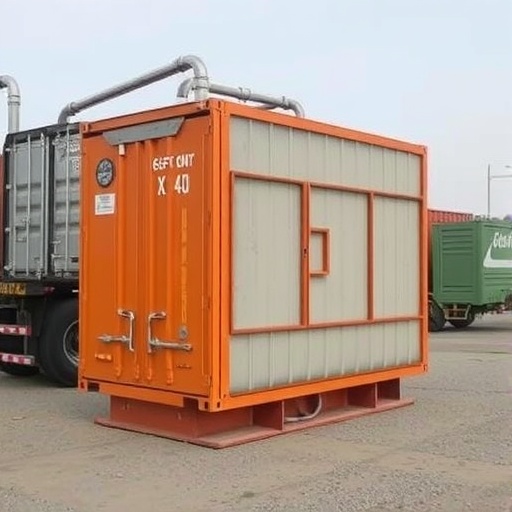In recent years, the relentless rise in air pollution has spurred scientists and engineers to seek innovative solutions for mitigating emissions from diesel engines. Among the various pollutants emitted, particulate matter and sulfides stand out for their detrimental effects on human health and the environment. Z.H. Kafash and M.R. Mahmoudian have undertaken a pivotal study that investigates a novel approach to filtering these harmful emissions, incorporating a back filter system designed to enhance the efficacy of diesel exhaust systems.
The significance of this research lies not only in its potential to reduce harmful exhaust emissions, but also in the selection of specific metals used in the construction of these filters. The authors explore how different metal types interact with exhaust particles and gases, thereby influencing the filter’s overall performance. By addressing the intersection of materials science and environmental engineering, this study paves the way for advancements in cleaner combustion technologies that can significantly benefit urban air quality.
Throughout the investigation, the authors meticulously designed experiments to evaluate the back filter’s effectiveness across various filtering scenarios. This involved testing different types of metals, such as aluminum, stainless steel, and specialized alloys, each known for their unique properties in thermal conductivity, corrosion resistance, and strength. The results indicated substantial variations in performance metrics, shedding light on the critical importance of material selection in engineering solutions aimed at exhaust emission reduction.
Furthermore, the study uniquely links the mechanics of different filter configurations with metal properties. For instance, filters made from high-density metals demonstrated superior performance in trapping fine particulate matter compared to their lighter counterparts. This revelation underscores the necessity for a tailored design approach, where the choice of material can significantly enhance filtration efficiency. It is this kind of innovative thinking that could revolutionize the way diesel engines are treated for emission control.
As part of the filtering mechanism, the authors employed an intricate arrangement that allowed the back filter to capture not only particulate matter but also gaseous emissions that should be neutralized before reaching the atmosphere. This dual-function capability positions the proposed back filter as a versatile addition to existing exhaust systems. Through a systematic examination of emission profiles, the study reveals that specific metal combinations can create an optimal environment for reducing both particulate and sulfide emissions simultaneously.
One of the standout findings of the research is the impact of metal type on the lifetime and durability of the filters. Filters constructed from more durable and heat-resistant materials showed a lower degradation rate, leading to a longer operational lifespan. This not only has implications for cost savings over time but also influences the overall environmental footprint of maintaining such technologies. Extended filter life means reduced waste and less frequent replacements, which can be incredibly beneficial in mitigating the environmental impact of industrial operations.
In addition to examining efficacy, the study also considered the economic ramifications of implementing such back filter systems in conventional diesel engines. The authors conducted a comparative analysis, weighing the upfront costs of different metal types against the long-term savings from reduced emissions and improved fuel efficiency. This aspect of the research highlights the balance required between engineering innovation and practical economic considerations, proving that environmental sustainability can indeed align with fiscal responsibility.
Moreover, Kafash and Mahmoudian discussed the regulatory implications of their findings. With many regions tightening emission standards, the development of advanced filtering technologies becomes increasingly critical. Their research suggests that utilizing back filters made from optimized metal compositions could lead to significant compliance advantages for industries reliant on diesel engines, ultimately contributing to a wider adoption of clean technologies across various sectors.
The potential applications of this technology extend beyond transportation; industrial stationary engines, generators, and even marine applications stand to benefit significantly from the implementation of back filters. As industries worldwide continue to grapple with stringent emission regulations, solutions like this will become essential for ensuring compliance and enhancing air quality across urban and rural environments alike.
Furthermore, the research opens avenues for future studies to explore other materials and advanced composites that could further enhance the performance of back filters. The integration of nanotechnology, for instance, might lead to even greater efficiencies in particle capture and emission neutralization. As the quest for cleaner energy solutions continues, the insights gathered from this research could become foundational for subsequent innovations in emission control technologies.
While the findings are promising, the authors also acknowledge the ongoing challenges in the adoption of such advanced filtering technologies in diesel engines. Barriers related to cost, existing infrastructure, and industry acceptance must be navigated carefully to foster a more extensive shift towards cleaner diesel technology. Their research serves as a clarion call to policymakers and industry leaders to invest in transformative technologies that can fundamentally alter the trajectory of diesel emission regulation and compliance.
In conclusion, the study by Kafash and Mahmoudian not only illuminates the critical intersection between material engineering and environmental sustainability but also establishes a pathway for the development of back filters capable of significantly reducing harmful diesel emissions. The long-term implications of this research could transform not only individual industries but also contribute significantly to global efforts to combat air pollution and its associated health risks. As science continues to advance in this arena, the collaboration between material scientists and environmental engineers will undoubtedly become crucial in the pursuit of cleaner air and a healthier planet.
Subject of Research: Reducing particulate matter and sulfide emissions from diesel engine exhaust using a back filter.
Article Title: Introducing a back filter: the impact of metal type on reducing particulate matter and sulfide emissions from diesel engine exhaust.
Article References:
Kafash, Z.H., Mahmoudian, M.R. Introducing a back filter: the impact of metal type on reducing particulate matter and sulfide emissions from diesel engine exhaust.
Environ Sci Pollut Res (2025). https://doi.org/10.1007/s11356-025-36938-8
Image Credits: AI Generated
DOI:
Keywords: Diesel emissions, particulate matter, back filters, sulfide emissions, environmental engineering, materials science.




